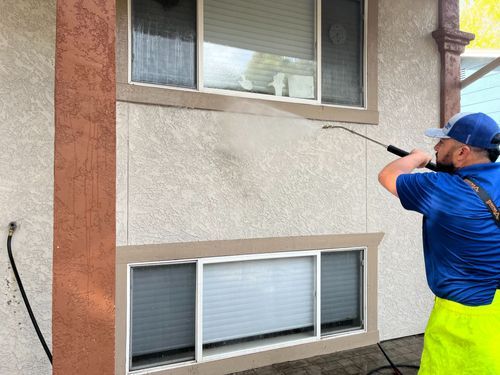
Stucco is a beautiful and versatile exterior finish, offering an attractive Mediterranean or Southwestern aesthetic that many homeowners love. But while stucco is durable, it’s also porous and prone to collecting dirt, mildew, algae, and stains over time—especially in humid or dusty environments.
When it’s time to clean stucco, pressure washing can be your best friend—or your worst enemy. Used correctly, a pressure washer can make stucco look fresh and new. Used improperly, it can crack, gouge, or even dislodge sections of the wall. 😬
In this guide, we’ll cover how to pressure wash stucco safely and effectively, step by step. 🧼🏡
🧠 Why Stucco Needs a Gentle Touch
Stucco isn’t like concrete or brick—it’s more fragile and more susceptible to damage from high-pressure streams. Its rough texture holds onto grime, but the same texture also means water can force its way inside the pores and under the surface.
Common issues from incorrect pressure washing include:
- Cracking or chipping
- Water intrusion into walls
- Damaged window seals
- Deteriorating paint or finishes
That’s why it’s important to treat stucco with care—and to know what pressure, tools, and methods are safe.
🧰 What You’ll Need
To pressure wash stucco the safe way, gather:
- Electric or gas pressure washer (1,200–1,800 PSI max)
- 25° (green) or 40° (white) spray nozzle
- Garden hose
- Pump sprayer or foam cannon
- Non-corrosive cleaner (for stucco/masonry)
- Soft-bristle brush or microfiber mop
- Painter’s tape and plastic sheeting
- Safety glasses and gloves
⚠️ Avoid turbo or 0° nozzles—they are far too aggressive for stucco.
Browse Amazon Here For Top Rated Power Washers And Accessories
🛠️ Step-by-Step: How to Pressure Wash Stucco Safely
1️⃣ Inspect the Stucco
Before you do anything:
- Look for cracks, chips, or holes in the stucco
- Check for signs of mildew, mold, or algae
- Patch any damage before washing to avoid making it worse
🧱 Pro tip: Use caulk or stucco patching compound to fix any weak spots in advance.
2️⃣ Protect Windows and Doors
Use painter’s tape and plastic sheeting to:
- Cover nearby windows and doors
- Shield light fixtures, outlets, or other sensitive fixtures
- Prevent water intrusion into window seals or door frames
3️⃣ Pre-Wet the Surface
- Rinse the entire area to saturate the stucco
- This helps reduce absorption of cleaner and keeps the surface cool
💡 Always clean on a cool, overcast day—or early morning—to prevent streaks from quick drying.
4️⃣ Apply Cleaning Solution
Use a pump sprayer or foam cannon with stucco-safe detergent:
- Apply from bottom to top (to avoid streaking)
- Let the solution dwell for 5–10 minutes
- Do not let it dry—mist it with water if needed
If you notice mold or algae, use a solution that includes mildewcide or algaecide for best results.
5️⃣ Gently Scrub (If Needed)
For stubborn spots or textured areas:
- Use a soft-bristle brush or microfiber mop
- Gently scrub without grinding into the stucco
- Focus on dirty areas like the bottom of walls, under eaves, or around vents
6️⃣ Pressure Wash with Care
Attach a 40° or 25° nozzle:
- Start with low pressure and adjust as needed
- Hold the wand 2–3 feet from the surface
- Spray at a 45° angle, moving side to side in overlapping passes
- Work from top to bottom to rinse away debris
Never linger in one spot. Keep the wand moving constantly to avoid streaks or damage.
7️⃣ Final Rinse and Dry
Once clean:
- Do a thorough rinse with clean water
- Check corners and textured areas for leftover suds
- Let the walls air dry naturally, or pat dry window sills and ledges
🌿 Optional: Eco-Friendly Stucco Cleaning Solutions
Prefer a natural cleaner? Mix:
- 1 gallon of warm water
- ½ cup of white vinegar
- A few drops of dish soap
Spray it on with a pump sprayer and scrub lightly before rinsing. Great for removing mildew and grime with minimal environmental impact. ♻️💚
🗓️ How Often Should You Clean Stucco?
| Condition | Cleaning Frequency |
|---|---|
| Humid climate | Every 6–9 months 🌧️ |
| Dry, dusty region | Once per year 🌵 |
| Shaded/wet areas | Twice per year 🌳 |
| General maintenance | Annually 🗓️ |
❌ Mistakes to Avoid
- ❌ Using over 2,000 PSI
- ❌ Spraying up into soffits or vents
- ❌ Holding the nozzle too close
- ❌ Skipping surface inspection beforehand
- ❌ Using bleach or harsh chemicals on colored stucco
🧼 Aftercare Tips
Once your stucco is dry and clean:
- Check again for cracks or chipping
- Apply a fresh coat of breathable stucco paint or sealant if needed
- Trim vegetation near the home to reduce future mildew growth
- Install gutters or splash guards if water consistently stains certain areas
💬 Final Thoughts
Pressure washing stucco can be safe and effective—as long as you treat it with respect. Using low pressure, the right cleaning solutions, and good technique, you can refresh your stucco exterior without risking costly repairs. 🏠✨
So take your time, prep thoroughly, and work gently. Your stucco walls will thank you with a fresh, clean finish that looks great from the curb and holds up for years to come.
Browse Amazon Here For Top Rated Power Washers And Accessories



